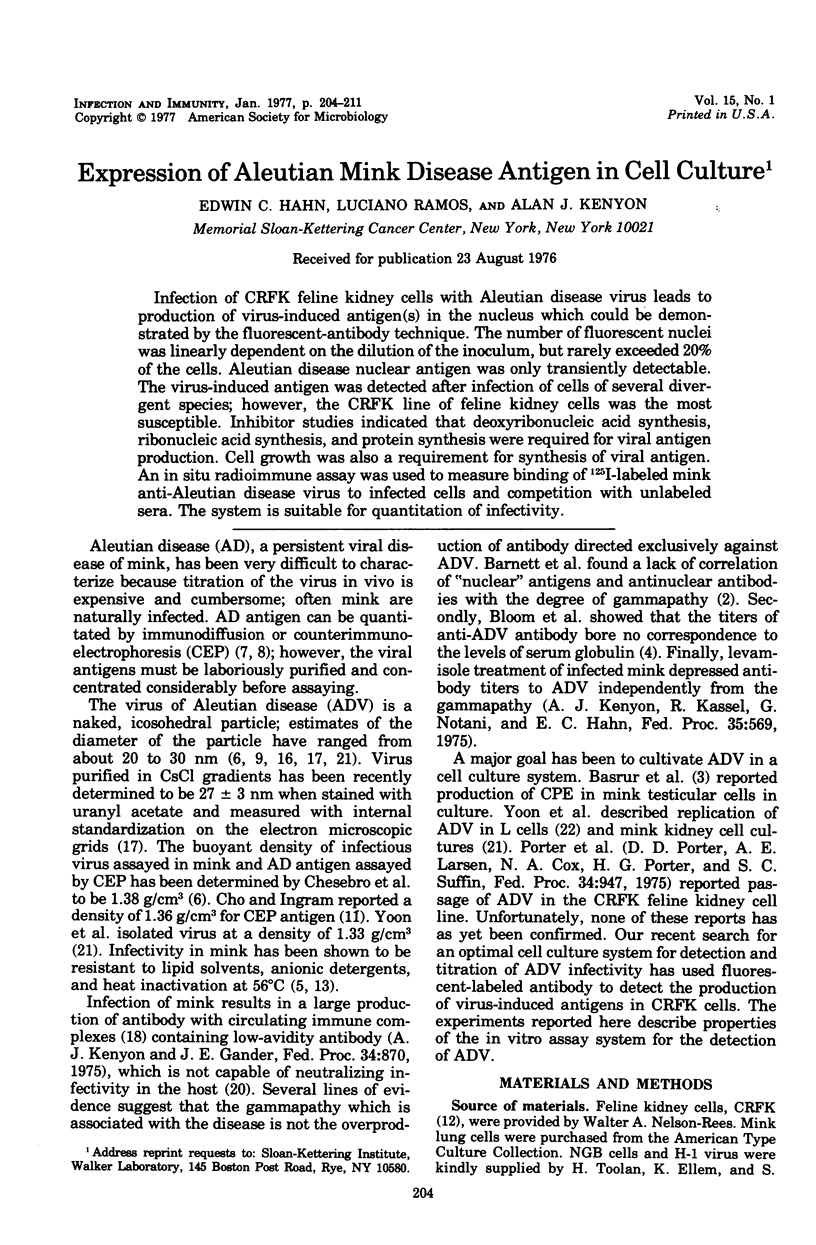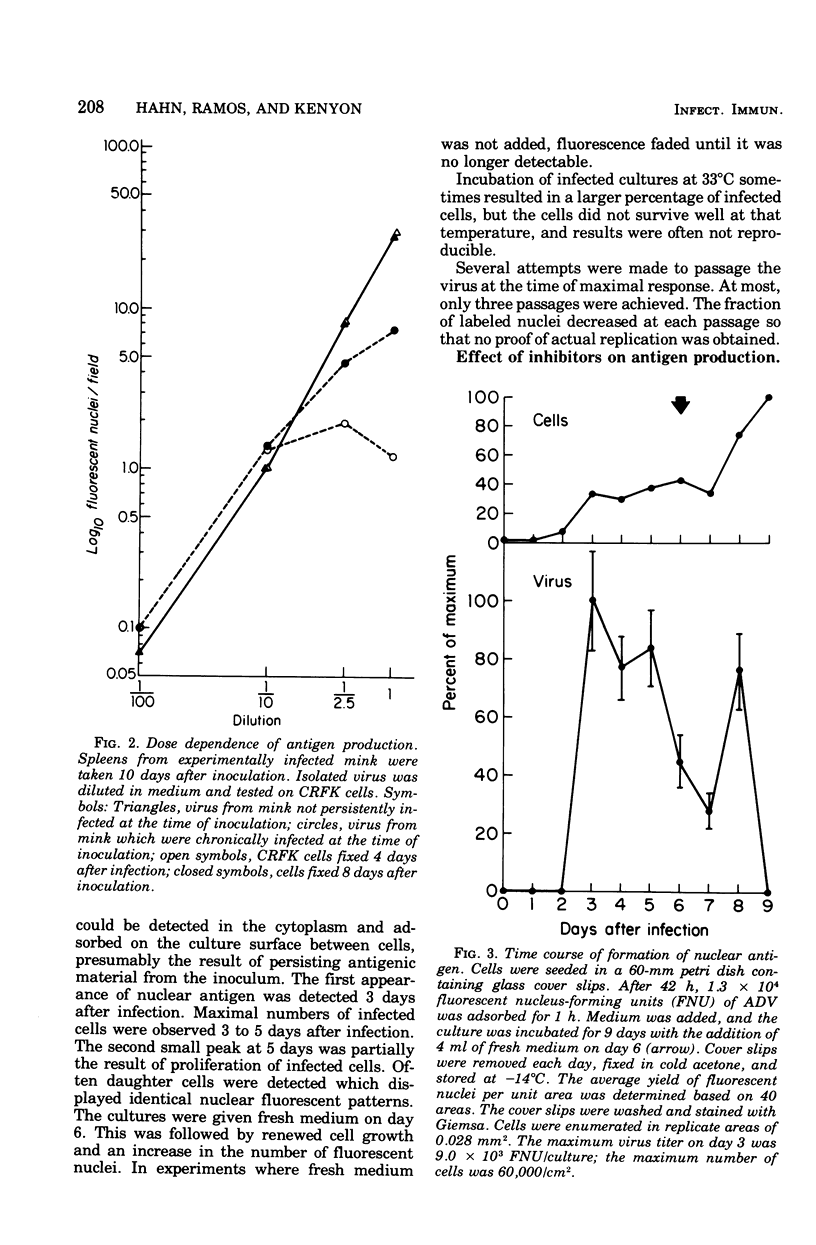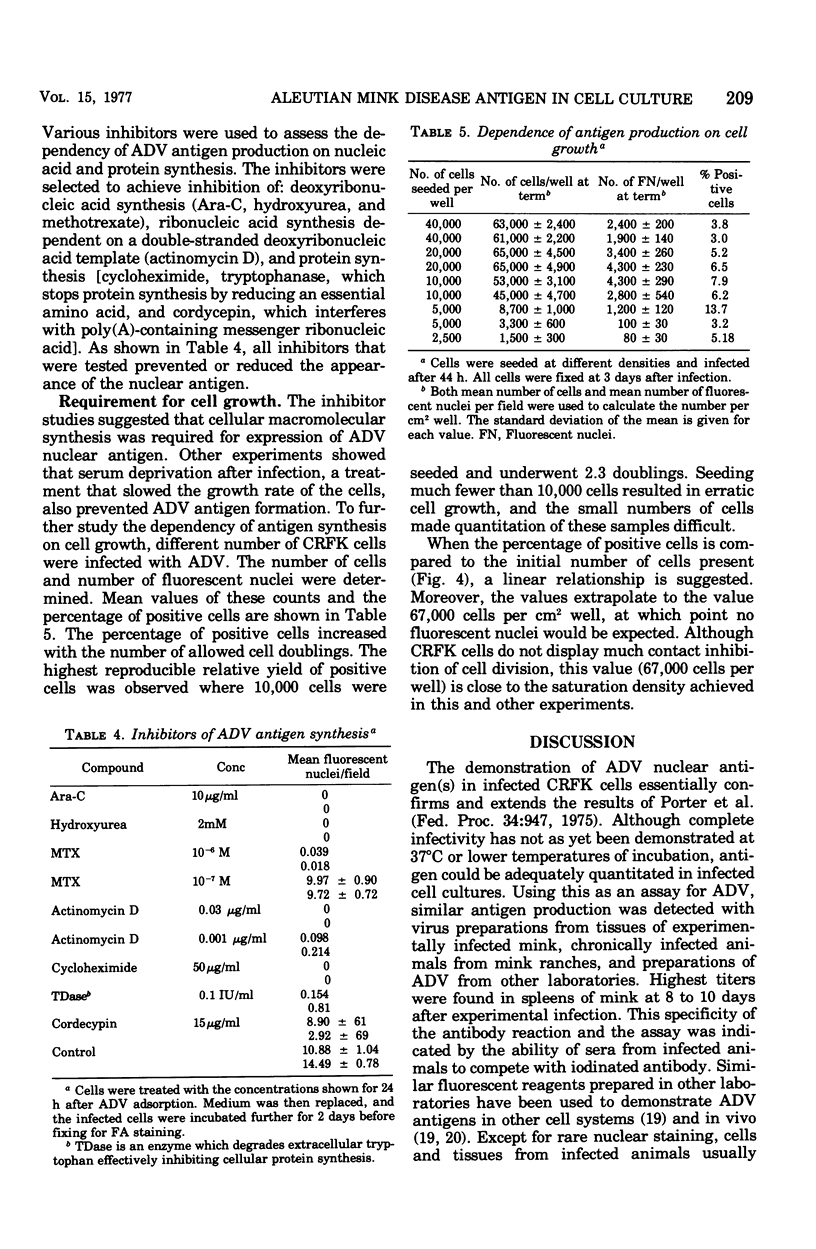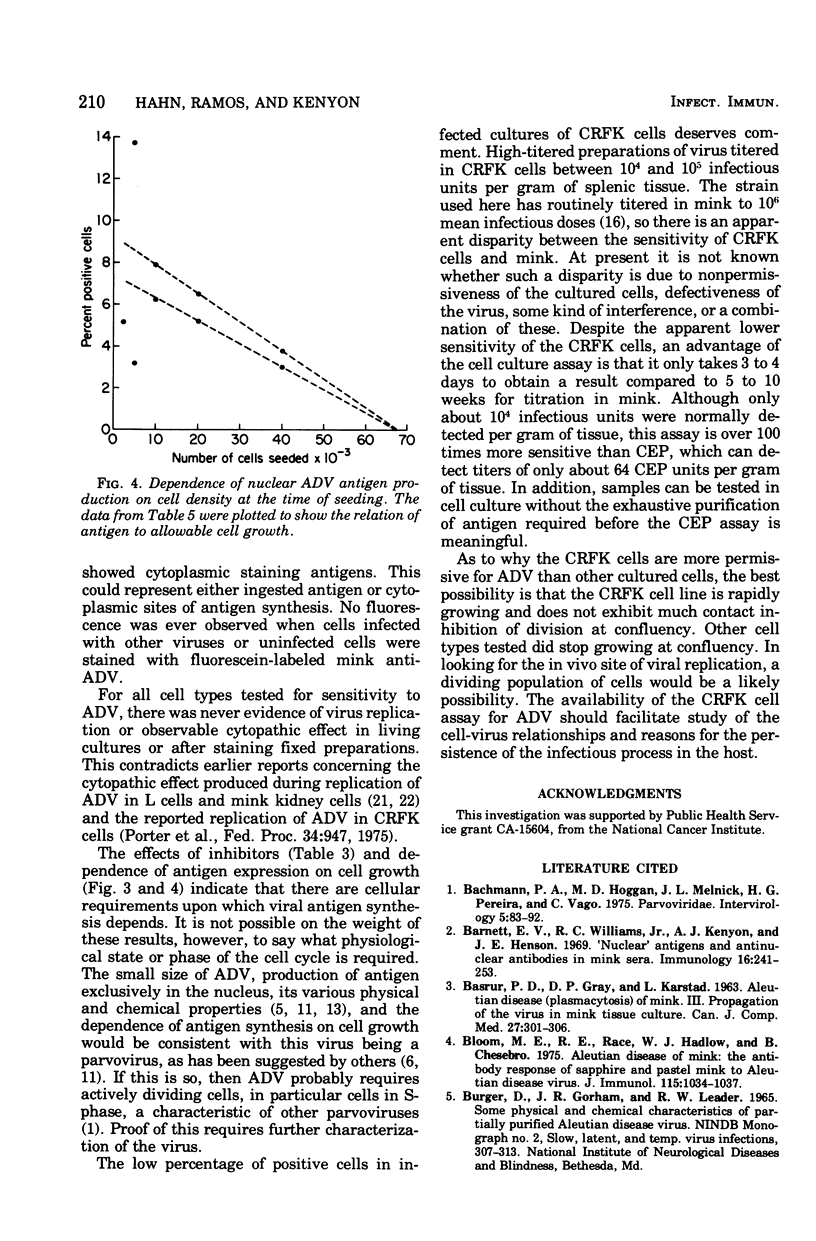Abstract
Infection of CRFK feline kidney cells with Aleutian disease vurus leads to production of virus-induced antigen(s) in the nucleus which could be demonstrated by the fluorescent-antibody technique. The number of fluorescent nuclei was lineraly dependent on the dilution of the inoculum, but rarely exceeded 20% of the cells. Aleutian disease nuclear antigen was only transiently detectable. The virus-induced antigen was detected after infection of cells of several divergent species; however, the CRFK line of feline kidney cells was the most susceptible. Inhibitor studies indicated that deoxyribonucleic acid synthesis, ribonucleic acid synthesis, and protein synthesis were required for viral antigen production. Cell growth was also a requirement for synthesis of viral antigen, An in situ radioimmune assay was used to measure binding of 125I-labeled mink anti-Aleutian disease virus to infected cells and competition with unlabeled sera. The system is suitable for quantitation of infectivity.
Full text
PDF







Images in this article
Selected References
These references are in PubMed. This may not be the complete list of references from this article.
- Bachmann P. A., Hoggan M. D., Melnick J. L., Pereira H. G., Vago C. Parvoviridae. Intervirology. 1975;5(1-2):83–92. doi: 10.1159/000149884. [DOI] [PubMed] [Google Scholar]
- Barnett E. V., Williams R. C., Jr, Kenyon A. J., Henson J. E. 'Nuclear' antigens and antinuclear antibodies in mink sera. Immunology. 1969 Feb;16(2):241–253. [PMC free article] [PubMed] [Google Scholar]
- Basrur P. K., Gray D. P., Karstad L. Aleutian Disease (Plasmacytosis) of Mink III. Propagation of the Virus in Mink Tissue Cultures. Can J Comp Med Vet Sci. 1963 Dec;27(12):301–306. [PMC free article] [PubMed] [Google Scholar]
- Bloom M. E., Race R. E., Hadlow W. J., Chesebro B. Aleutian disease of mink: the antibody response of sapphire and pastel mink to Aleutian disease virus. J Immunol. 1975 Oct;115(4):1034–1037. [PubMed] [Google Scholar]
- Chesebro B., Bloom M., Hadlow W., Race R. Purification and ultrastructure of Aleutian disease virus of mink. Nature. 1975 Apr 3;254(5499):456–457. doi: 10.1038/254456a0. [DOI] [PubMed] [Google Scholar]
- Cho H. J., Ingram D. G. Antigen and antibody in Aleutian disease in mink. I. Precipitation reaction by agar-gel electrophoresis. J Immunol. 1972 Feb;108(2):555–557. [PubMed] [Google Scholar]
- Cho H. J., Ingram D. G. Antigen and antibody in Aleutian disease in mink. II. The reaction of antibody with the Aleutian disease agent using immunodiffusion and immunoelectroosmophoresis. Can J Comp Med. 1973 Jul;37(3):217–223. [PMC free article] [PubMed] [Google Scholar]
- Cho H. J., Ingram D. G. Isolation, purification and structure of Aleutian disease virus by immunological techniques. Nat New Biol. 1973 Jun 6;243(127):174–176. doi: 10.1038/newbio243174a0. [DOI] [PubMed] [Google Scholar]
- Cho H. J., Ingram D. G. Pathogenesis of aleutian disease of mink: nature of the antiglobulin reaction and elution of antibody from erythrocytes and glomeruli of infected mink. Infect Immun. 1973 Aug;8(2):264–271. doi: 10.1128/iai.8.2.264-271.1973. [DOI] [PMC free article] [PubMed] [Google Scholar]
- Cho H. J., Ingram D. G. The antigen and virus of Aleutian disease in mink. J Immunol Methods. 1974 Mar;4(2):217–228. doi: 10.1016/0022-1759(74)90065-9. [DOI] [PubMed] [Google Scholar]
- Crandell R. A., Fabricant C. G., Nelson-Rees W. A. Development, characterization, and viral susceptibility of a feline (Felis catus) renal cell line (CRFK). In Vitro. 1973 Nov-Dec;9(3):176–185. doi: 10.1007/BF02618435. [DOI] [PubMed] [Google Scholar]
- Eklund C. M., Hadlow W. J., Kennedy R. C., Boyle C. C., Jackson T. A. Aleutian disease of mink: properties of the etiologic agent and the host responses. J Infect Dis. 1968 Dec;118(5):510–526. doi: 10.1093/infdis/118.5.510. [DOI] [PubMed] [Google Scholar]
- GOLDSTEIN G., SLIZYS I. S., CHASE M. W. Studies on fluorescent antibody staining. I. Non-specific fluorescence with fluorescein-coupled sheep anti-rabbit globulins. J Exp Med. 1961 Jul 1;114:89–110. doi: 10.1084/jem.114.1.89. [DOI] [PMC free article] [PubMed] [Google Scholar]
- Kenyon A. J., Gander J. E., Lopez C., Good R. A. Isolation of Aleutian mink disease virus by affinity chromatography. Science. 1973 Jan 12;179(4069):187–189. doi: 10.1126/science.179.4069.187. [DOI] [PubMed] [Google Scholar]
- Notani G. W., Hahn E. C., Sarkar N. H., Kenyon A. J. Characterisation of Aleutian disease antigens. Nature. 1976 May 6;261(5555):56–58. doi: 10.1038/261056a0. [DOI] [PubMed] [Google Scholar]
- Porter D. D., Larsen A. E., Porter H. G. The pathogenesis of Aleutian disease of mink. I. In vivo viral replication and the host antibody response to viral antigen. J Exp Med. 1969 Sep 1;130(3):575–593. doi: 10.1084/jem.130.3.575. [DOI] [PMC free article] [PubMed] [Google Scholar]
- Yoon J. W., Dunker A. K., Kenyon A. J. Characterization of Aleutian mink disease virus. Virology. 1975 Apr;64(2):575–580. doi: 10.1016/0042-6822(75)90137-3. [DOI] [PubMed] [Google Scholar]
- Yoon J. W., Kenyon A. J., Good R. A. Demonstration of Aleutian mink disease virus in cell culture. Nat New Biol. 1973 Oct 17;245(146):205–207. doi: 10.1038/newbio245205a0. [DOI] [PubMed] [Google Scholar]



